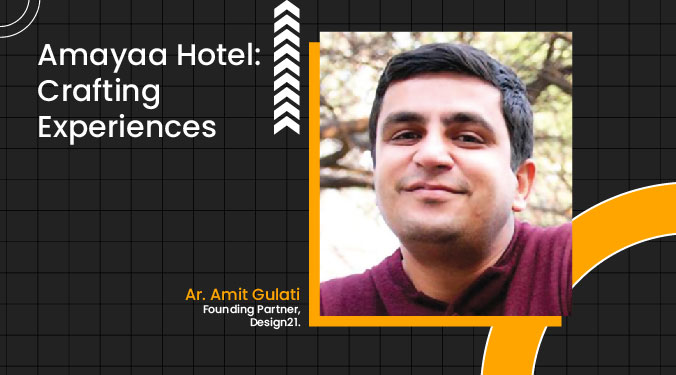Amayaa Hotel: Crafting Experiences

Ar. Amit Gulati, Founding Partner, Design21, speaks on how each space in the Amayaa Hotel has been insulated from heat to maintain energy efficiency in the interiors.
Why did you choose to specialise in hospitality projects?
Hospitality is an ever-evolving segment with an increasing need for innovation. Each new project demands a distinguished design process. Hospitality projects involve designing every detail with end users in mind. Crafting a personalised experience for an individual while enduring the needs of the public is a complex challenge that is exciting and rewarding for an architect in a hospitality project. Especially the Amayaa hotel, designed in a historical location, allowed us to communicate the city’s story to the travellers through architecture.
What was the initial idea for this project? How is this project impacting the urban and social environment?
The Amayaa hotel is situated at the centre of the Ganges valley in Banaras, offering a tranquil ambience to relax, unwind, and explore the city. This project’s initial idea was to reintroduce Varanasi’s heritage with a mid-century vibe in this contemporary era. Varanasi, as it is presently known, is a city that is continually evolving, as evidenced by how architects, designers, and urban planners are trying to construct a smarter city for the future. We at Design21 strive to enhance the city’s skyline in several ways by truthfully reflecting the heritage of Varanasi. An old, hand-drawn black-andwhite sketch of Banaras from the British era is framed in each guest room, narrating the city’s real story. The raised deck further along the flooring in the guest room welcomes the eyes with a wide panoramic view that brings the context of the city closer to the guest through the large curved windows. The glass windows in the lobby have been customised to optimise heat gain while ensuring adequate natural light. Every space has been insulated from heat to maintain energy efficiency in interiors. The spatial narrative has been planned and organised with building performance in mind.
Any kind of challenges you faced while designing it?
The biggest challenge was to execute the design in an operational hotel. It needed immense planning strategies to outline new infrastructure and integrate it with the existing environment. Representing the rich culture and heritage of the city in a modern luxury hotel was highly critical. Therefore, it was vital to infuse historical details of Varanasi while maintaining a contemporary flavour in the hotel design.
How far have you adopted new technologies for this project?
Technology affects how architects design buildings and even the user experience. The role of architects is to embrace these technological advancements and innovative ideas to offer unique experiences to the users. The hospitality industry has been one of the rapid adopters of new technologies, from experiential design to energy efficiency. For instance, this hotel’s lobby exudes an enticing charm with the alternately positioned wood, exquisite marble, reflecting glass tiles, and towering textured ceilings alive with a spotlight cast on the marble floors of the reception. Technology has allowed for the intricate fabrication of jali motifs in the lounge, which enhances the spatial appeal and also brings a dramatic vibe to the space.
What is the sustainability perspective of this project?
This project defines and endorses sustainability in many ways, from the restoration of the city’s heritage to the use of energy-efficient fixtures. The hotel uses a natural and soulful material palette, including wood and marble. The intricately carved jaali walls in the lounge bring natural light that brightens up the calming atmosphere and falls on the comfortable couches and chairs with wooden tables. The grid tile wall design with punctures in between carrying pots of vibrant flowers and little leaves ought not to be overlooked. Solid wood, prized for its sustainability and peculiarity, is utilised at the guest room entrance. LED lights have been used throughout the hotel to enhance energy efficiency and promote sustainability.
Cookie Consent
We use cookies to personalize your experience. By continuing to visit this website you agree to our Terms & Conditions, Privacy Policy and Cookie Policy.









